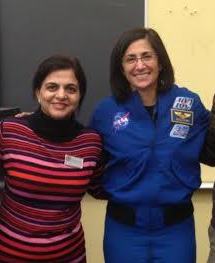Shoot for the moon: astronaut advises, recounts experiences

Stott poses with chemistry teacher Sarwat Jafry. Stott and Jafry are united by their love of science.
February 25, 2014
Astronaut Nicole Passonno Stott has met the founder of Cirque de Soleil, lived underwater and traveled to space. Twice. Stott spoke at a joint-Science and Math Club (SAMC) and Women Helping Empower Each Other (WHEE) meeting Feb. 7.
Before her first long-duration space flight, Stott served as a crew member on the ninth and longest to date NASA Extreme Environment Mission Operations (NEEMO 9) mission. The seven-person program was conducted in an underwater habitat near the Florida coast for 18 days.
“How you live while you’re there is about how you work as a team,” Stott said. “You have to be very diligent about the planning you do to keep yourself alive.”
In addition to testing technology to be used in space on NEEMO, Stott trained for the space expedition in Russia, where she completed a Russian immersion course. While training in Russia, Stott endured the coldest winter Russia had experienced in over 100 years. The goal of the training was to prepare the astronauts for extreme situations that could occur in space if something went wrong.
“In real life, you’d never want to be in those situations,” Stott said. “However, if you were, you want to know that you’d be as prepared as you can possibly be.”
Stott’s first takeoff occurred August 28, 2009. Within the span of eight minutes, she left earth’s orbit and entered outer space. Stott spent a total of 91 days in space, once performing a long-duration space walk for over six hours.
“You don’t believe the launch is ever going to happen,” Stott said. “But once it does, all you want to do is get out of your seat and start floating.”
Stott’s lifestyle changed dramatically once she entered space. In order to prevent their muscles and bones from atrophying, astronauts must exercise for at least two hours each day.
The crew even brought mice in order to investigate the causes and treatment of osteoporosis by observing how the atmosphere affected the animals.
“The brain and body figure out really quickly that you don’t need muscles or skeleton anywhere,” Stott said.
In addition to testing on mice, plants and herself, Stott interacted with astronauts from China, Japan and Russia as well as space tourists, including the founder of Cirque du Soleil, Guy Laliberte.
Stott also observed space walks from the Cupola Observational Module, a work area that featured simulators as well as launching, landing and robotic activities.
“It’s a lot like playing a video game,” Stott said.



